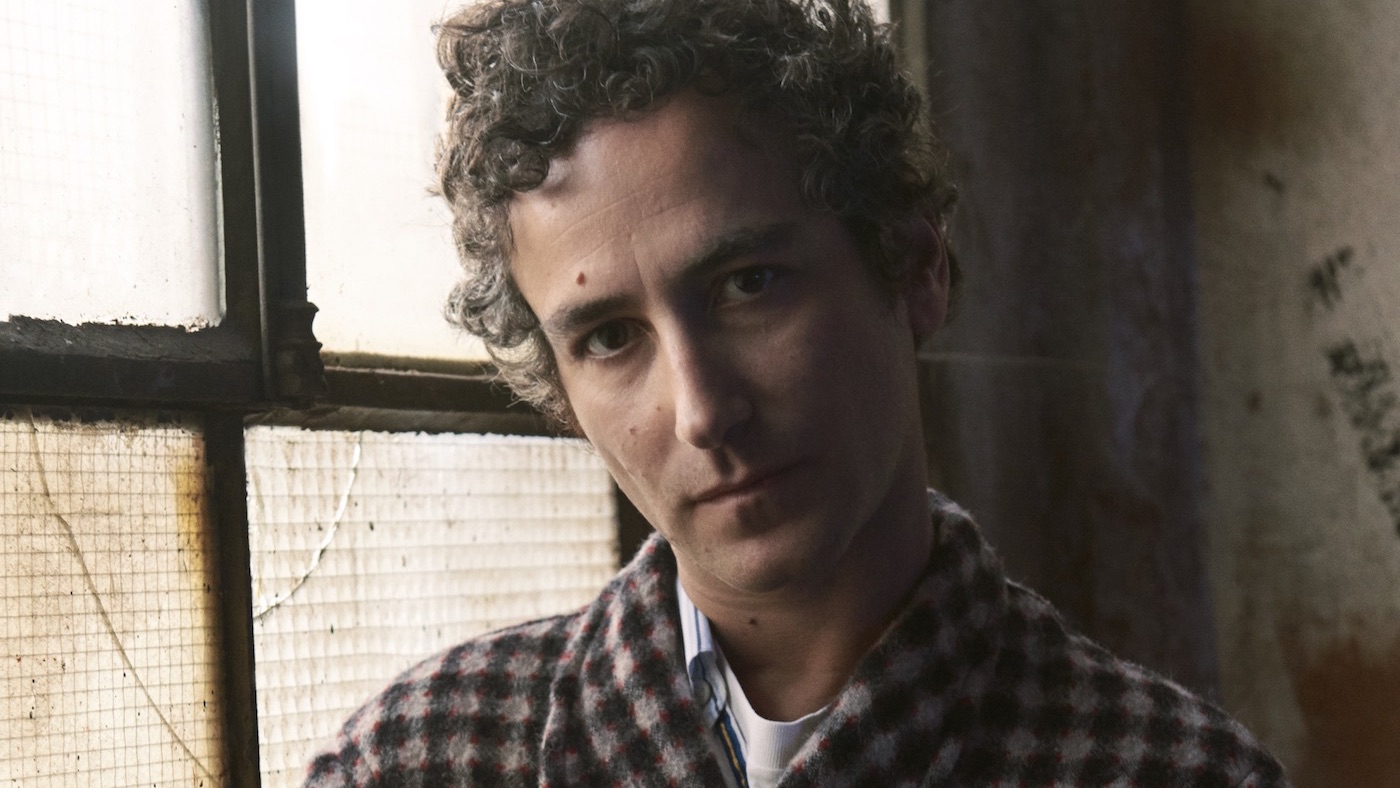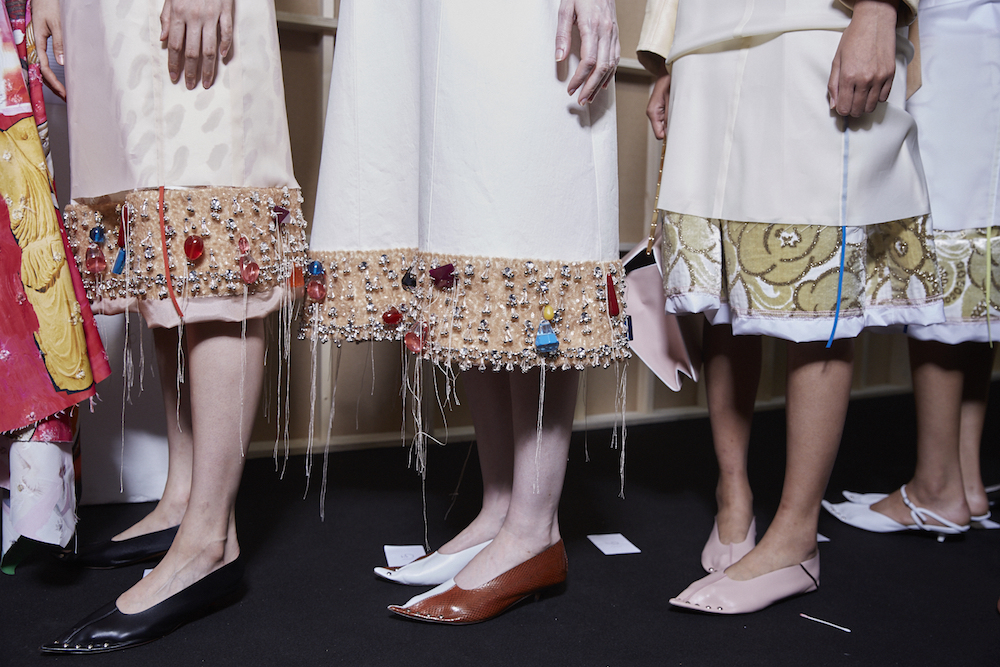Reimagining Marni: Francesco Risso talks
Marni’s Francesco Risso has a talent for turning abstract thinking into beautiful designs

Minutes after taking his final bow to mark the end of Marni’s AW19 menswear show in Milan, creative director Francesco Risso returns backstage to a bustling scene that can only be described as well-practised choreography. Models, production runners and Risso himself are navigating their way around clothing rails, make-up tables and mounds of white garment bags while a dry ice machine continues to puff out clouds of white mist. It’s an industrious but dream-like environment that ironically echoes the very theme of the show.
For this, Risso’s ninth catwalk collection for the Italian fashion house, the designer imagined downy angora knitwear in multicoloured stripes, oversized tailoring, and outerwear in fantastical animal prints. Risso himself is today dressed in a diamond-pattern dressing robe – shawl collar left open, cloth-belt untied – accessorised with a Wee Willie Winkie-style cotton nightcap, complete with pointy tip and pompom.
Since joining Marni as creative director in October 2016, Risso has frequently explored the phenomenology of dreams and sleep. His AW17 menswear debut included mattress-stripe suits made from quilted eiderdown-like fabrics; he has conjured up ribbon-tied bed jackets (also AW17), pyjama trousers with drawstring waists (SS19 menswear), and ponchos assembled from striped woollen blankets (AW18). Last spring, outsize clutch bags took the shape of soft furry pillows, to be cradled close to the body. Risso’s sets have repeatedly revisited this quiescent theme: at Marni’s SS19 presentation last September, guests were seated on vintage beds, all perfectly made-up with pillows, duvets and comforters. The soundtrack to the AW19 menswear show included a contemporary remix of Claude Debussy’s Prélude à l’après-midi d’un faune, the French composer’s 1894 orchestral masterpiece inspired by a Stéphane Mallarmé poem, which was itself inspired by a faun’s fantastical daydreams.
The Week
Escape your echo chamber. Get the facts behind the news, plus analysis from multiple perspectives.

Sign up for The Week's Free Newsletters
From our morning news briefing to a weekly Good News Newsletter, get the best of The Week delivered directly to your inbox.
From our morning news briefing to a weekly Good News Newsletter, get the best of The Week delivered directly to your inbox.
Dreams are hard to place, but there are clues that point to Risso’s fascination with escapism, including his office at Marni’s Milan headquarters, which are located in a built-up residential area to the east of the city. “I come here sometimes to gather my thoughts, to find a bit of calm,” he says when we meet a few days before January’s AW19 show.

One of his first decisions when furnishing the space was to install a cork noticeboard, which runs the entire length of one wall and is laden with images – a homemade surrealist collage that serves as inspiration. It includes a headshot of aristocratic German model Veruschka von Lehndorff with crystal-tipped eyelashes. “[The noticeboard] is almost like my notebook,” Risso says. “There is no order. It’s things I want to remember.”
Risso, 36, is looking decidedly debonair, dressed in a dramatic emerald-green coat printed all over with the black whiskers and gleaming yellow eyes of a Cheshire cat. His plimsolls are only just visible through the office's luxurious thick-pile rug. There are dozens of art books, souvenirs, and a curious leather footstool in the shape of a bulldog. On his desk, the Italian keeps a knitted handbag – a cherished gift, he tells me, that was made for him by a former team member as a farewell present. Next to it are a selection of squeaky vintage rubber toys by Czech designer Libuše Niklová. “There is a lot of crap!” says Risso, cheerfully. “I am obsessed with eBay. I can bid for hours and hours and then I win it all! I am so bad, and then I get a lot of crap coming [in the post]. I like to collect.”
Today, Marni HQ is a hive of activity, as the international team are busy preparing the upcoming collection. Each Marni sample is sketched, cut and assembled on site; the building is home to designers, patternmakers and tailors. There are artisans perfecting accessories, while others finish vibrant pieces of costume jewellery. “[Coming here] was very emotional,” says Risso, recalling his first day on the job. “I remember the first sensation that I had was this very strong sense of creativity. It’s quite rare to enter a space and feel that vibe immediately. There was – and there still is – a freedom of working, a freedom of making things.”
A free daily email with the biggest news stories of the day – and the best features from TheWeek.com
Consuelo Castiglioni first established Marni as a womenswear brand in 1994, working in partnership with her husband Gianni, scion of the family-run fur business Ciwifurs, whose clients have included Valentino, Prada and Lanvin. Entirely self-taught, the Swiss-born designer quickly garnered loyal support for her eclectic work, and in 2002 she and Gianni extended their offering to include menswear, followed by children’s clothing and eyewear (2005). In 2013, Italian entrepreneur Renzo Rosso purchased a majority stake in the brand for his Only The Brave (OTB) Group, where Marni joined luxury brands including Viktor & Rolf and Maison Margiela. Castiglioni left the brand in October 2016. “I can’t think of any situation where it’s not hard or emotional for any designer who moves into a new house and tries to explore what it has to be in the future,” says Risso, her successor. “People were very attached to the idea of this brand and to the family, to Consuelo. They have done such an amazing job. I would buy a lot from Marni, and I was a fan of Consuelo. But I am not Consuelo. Somehow, even though I love what she has done, I have to try to be myself.”

Risso was born at sea on his parents’ wooden sailing boat and spent the first four years of his life traversing the Mediterranean. “My father was, at the time, quite passionate about sailing, and he and my mother decided to explore a different kind of lifestyle,” he explains. “They had this nomadic existence, and perhaps that’s what has made me hungry for life.” At the age of five, Risso moved to terra firma when his extended family, including his grandparents and half-brothers and sisters, relocated to a rambling estate in the north-west Italian city of Genoa. “My father was quite a hippy,” he explains. “He would arrive an hour late for lunch, and he would bring people. It would be a lunch for 30, every day. It was quite an intense childhood.”
One of Risso’s favourite boyhood pastimes was to explore his family’s wardrobes, chiefly his father’s. “He was quite eclectic,” Risso recounts. “He liked to ride horses in Brazil, so he would come back with these fringed pants – those pants you put over jeans. His favourite colour was pink, so he had this obsession with this pink cardigan with diamond buttons. He would make suits out of mattress fabrics from the ‘60s. He was quite a character, so going to steal some of his pieces was quite fun.”
Aged just 16, Risso left Genoa to travel further south; in Florence, he enrolled at private fashion college Polimoda, before transferring to Manhattan’s Fashion Institute of Technology (FIT), whose alumni include Calvin Klein, Carolina Herrera, Michael Kors and the late famed fashion illustrator Antonio Lopez. “I had this incredible course [taught by] these two very old tailors,” Risso remembers of his time at the school. “I would learn all the couture techniques: how to construct pieces and stitch and sew garments.” Upon graduating, Risso crossed the Atlantic to join the MA Fashion course at Central Saint Martins in London, where he was taught by the late Professor Louise Wilson. “What I loved about Louise was that she pushed me into finding my own inspiration,” he enthuses. “You have to learn how to find inspiration. You have to learn how to study, how to read.”
For his rst role following his MA graduation, Risso swapped London, where he spent days working and nights dancing at clubs including BoomBox in the city’s East End, for the quiet outskirts of Modena in Italy’s Emilia-Romagna region. “Suddenly, I opened my window and... I had this, like, very still scene of nothing,” he recounts. Risso had moved to Modena to work for designer Anna Molinari; after one year, he relocated to Milan and the ateliers of Alessandro Dell’Acqua. In 2006, he joined Prada, where for the next ten years he worked across special projects and the brand’s womenswear collections. “I am still in love with the memory of what happened there,” Risso says in mellifluous Italian tones. “In ten years, everything can happen at Prada. I had a great experience with Mrs [Miuccia] Prada and [design director] Fabio [Zambernardi]. You have to consider that in fashion, and in any kind of work after [a decade] it’s almost like you’re working with your family. At least for me, work is like: I go to the bathroom and I work, I go to bed and I work. It’s part of who you are.”
For Risso, inspiration can strike anywhere, as evidenced by this season’s collection, which drew from Tate Britain’s 2018 exhibition All Too Human. Uniting works by generations of British artists, including Lucian Freud, Francis Bacon, Michael Andrews and Jenny Saville, the display celebrated the intimate relationship between artist and sitter. “I was very impressed; it’s something that really remained in my heart somehow,” says Risso. “I came out of the exhibition quite excited. I thought how amazing [it was] that all these painters treated similar aspects of intimacy. On the canvas, it’s quite alive and that to me suggested the work in the studio.”
Focusing on the process of making rather than the finished product, Risso authored a womenswear collection that laid bare the intricate work carried out at the Marni ateliers: hems are left raw and fraying, the folds of loosely pleated skirts suggest fabrics draped on a dressmaker’s dummy. “You have to imagine the work that the painter does on the canvas,” Risso explained, post-show. “He makes stains before getting there, and that becomes the work itself.”
Collaborations with contemporary artists have long been a Marni bedrock. During Castiglioni’s tenure, the marque extended carte blanche to Richard Prince, Peter Blake and Ruth van Beek, and in 2010 YBA Gary Hume conceived a quartet of block-printed Marni T-shirts. Risso has continued the tradition: for last summer’s menswear collection, he tasked Venezuelan ceramist Magdalena Suarez Frimkess with creating a series of prints.
For AW18, American artist Frank Navin’s hand-drawn Pop Art-style illustrations of chairs, violins, monkeys and crystal formations were applied in haphazard fashion to various ready-to-wear garments and accessories; then SS19 saw Risso turn to German photographer Florian Hetz – known for his intimate and frank close-up images of the human body – and New York-based gurative painter Betsy Podlach. Depictions of the human body by both artist have been printed on cotton T-shirts and tote bags fashioned from coated PVC.
“I was completely surprised by the request from Marni about my work,” says Podlach, attesting to Risso’s intrepid spirit. “Francesco says he looks for work that interests him all over, and he does this himself. He looked all over the internet, encountered my work and decided it was what he wanted. I love that, because there were no connections or prior interactions that led [him to me] – just his search for what he was looking for.”
For all his reverie and fascination with unconscious thought and higher thinking, Risso has Marni’s future firmly thought out as a structured exploration into innovation and creative development, even though he likes to vocalise this desire in more poetic terms. “In my own experience, each collection [so far] was touching base with an aspect of the brand,” explains the designer, eager to get back to work. “It’s almost like you are landing on a new field and you explore this new garden and you are starting to plant seeds and you understand what can grow. Each season is kind of like finding a new piece of the garden.”
-
 Will there be peace before Christmas in Ukraine?
Will there be peace before Christmas in Ukraine?Today's Big Question Discussions over the weekend could see a unified set of proposals from EU, UK and US to present to Moscow
-
 Quiz of The Week: 6 – 12 December
Quiz of The Week: 6 – 12 DecemberQuiz Have you been paying attention to The Week’s news?
-
 The week’s best photos
The week’s best photosIn Pictures A man's best friend, the elephants in the room, and more